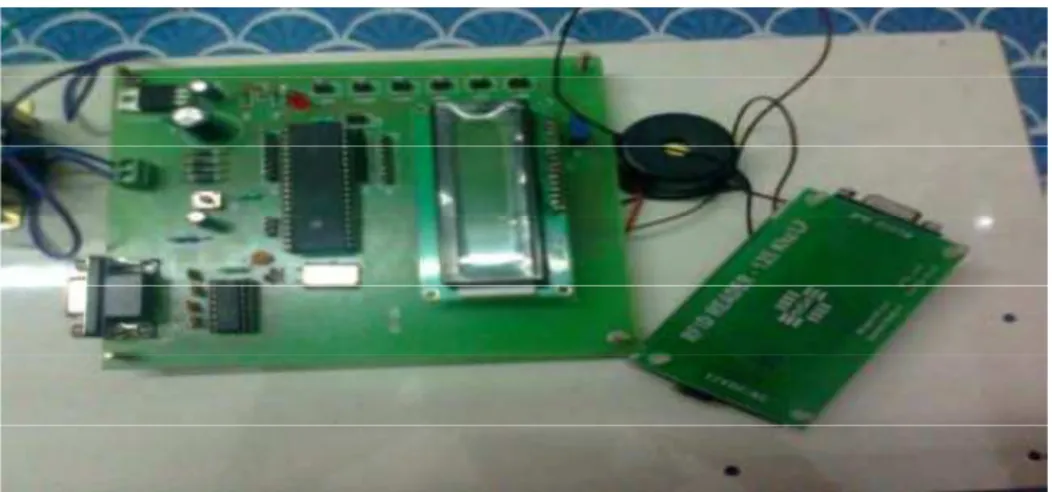RFID in cloud environment for Attendance
monitoring system
A.Parvathy#1, B. Rajasekhar#2, C.Nithya#3, K.Thenmozhi#4, J.B.B. Rayappan#5, Pethuru Raj##6 and Rengarajan Amirtharajan#7
#
School of Electrical & Electronics Engineering, SASTRA University,Tamil Nadu, India – 613401
##
Infrastructure Architect, Global Cloud Center of Excellence, IBM India, Bangalore, 560045
amir@ece.sastra.edu
Abstract—Radio Frequency Identification (RFID) initially is of great use in the marketing field render billing easy. It came into effect since world war-II attained its wide spread recognition only when Walmart introduced it as ‘mandate’. An object within the range of 20 feet can be easily tracked with the aid of its unique barcode using RFID chip. It is sophisticated than the primitive barcode techniques as there is no need of positioning of the scanner. Cloud computing is a system which provides access to all soft ware’s without installation, for a desired time period, at a specific cost, only with the help of a single web browser.. Interfacing RFID with cloud computing would be more beneficiary in solving current issues. Technological updates can be done without any technical support. This paper presents the overview of interfacing RFID with cloud computing for updating students’ attendance and updating it into the parents’ corner and faculty mails. By considering the present issue, providing unique RFID code to the students reduce malpractice and human error. Also Human resources can be saved by the application of cloud computing. Time management is the most effective advantage gained from the use of RFID and cloud computing.
I. INTRODUCTION
RFID, primitively used for automatic identification and tracking has now been extensively used for remote storage and retrieval of the data. RFID is similar to barcode but are far more efficient, easy to manufacture, and can be used in environments hostile to barcodes [1, 2]. RFID comprises of a tag ; usually sequestered on the object to be identified, an antenna that emits Radio Waves to excite the tag, a control unit governing the read/write commands between the RFID readers and the tags [3, 4] .Tags conserving fixed format data also constitutes of a wireless communication IC equal to the size of sesame. The newer to the system called signpost activates tags at the vicinity of about 123 KHz enabling identification of the tags at specific locations. The tags consist of the transmitter that sends out the carrier and receiver the picks up the backscattered signals.
The reader is made efficient enough to manage either RFID reader collisions or Tag collisions [5, 6] establishment of communication, etc. RFID systems adopt “Master Slave” principle such that all the readers and tags (slaves) are controlled by the application program (master). Readers execute the instruction from the application programs via tags that only reacts to the readers’ commands. RFID are classified into three categories: passive (without battery), active (with on-board battery) and BAP (on board battery that gets excited in the presence of RFID reader). The transponder could better be compared with RFID as the mode of communication between reader and the tag is wireless [7, 8].
Cloud computing was first introduced by Terso Solutions in 1998 after being inspired by salesforce.com. In 2011, two other companies hired cloud computing. It provides asset management, data security and cost reduction. Cloud computing has been gaining increased attention these years in the IT circles. It efficiently allows the data and applications to be managed by the server, reducing the burden of the server management that employs visualization technology [9]. It is arranged for a price through the internet. The RFID coalesced with cloud computing mainly concentrate on rendering a more secure and efficient system [10, 11]. RFID acts an entry point for linking cloud to support mobile systems [12]
The punched data has been sent to the server through internet, from where its updates to the faculty or the parent. It has gainsaid on the grounds of security, accuracy and efficient management for E- ID Management. Hence, it demands research on RFID based E-ID security platform to ensure efficient security management of personal real identity networks [11, 12]. Also the system using finger print based attendance known as biometric system was designed to manage time. It consists of a microprocessor card to monitor students’ or staffs’ routines. These are stored in the database for administrative reference.
of the controller and the respective session’s attendance automatically updated to the faculty and the parent interface via internet by cloud platform system. Cloud SQL server promises a scalable and highly available storage systems that bids familiar programming model for the web based programs that are extensive of classical relational database systems. RFID’ s functionalities can further be extended such that the radio waves returned from the tag could be transformed into a pattern which in turn is processed or stored by another system.
Figure.1 Proposed methodology
This practicality is likely to realize in exam halls or classrooms where the RFID card readers are stationed at the entrance to mark the student’s entry. A buzzer is also provided to alarm on the entry of an unintended person, which in turn creates data redundancy. The absence of redundancy data removal results in following three loads: the load of network bandwidth, the load of data processing, the load of data storage. The RFID data is matched with database; if it’s not matched add/update button will appear to enter the new records. Based on new reports the absence is send to the parents and inspection centre through cloud environment. Comingles of RFID and cloud computing is expected to superannuate the primitive avocations.
III. RESULTS &DISCUSSION
Figure 2 The prototype model without any RF ID tag with LCD
Figure 3 shows the archetype model of RFID reader with Transponder. When it is read by the reader the corresponding tag’s number will be demonstrated on LCD.
Figure 3 The prototype model when the tag number read by RF ID reader
Figure 4 shows the prototype of RFID with LCD display. The student’s register number is compared with database and the authorized register number is displayed on the LCD at the same time the absentees register numbers are send to their parents and to the corresponding exam centres.
Figure.5 Monitoring of attendance in system
Figure.7 Teacher’s Login page
Figure.9 Parent’s Web corner
Figure 5 represents the message confirmation window for monitoring of attendance, Figure 6, 7 and 8 represents the login web page, login for teachers and login for students respectively for attendance status update and verification. Figure 9 represents the parent’s web corner for checking their wards attendance status.
IV. CONCLUSION
In this paper projected an estimate that acknowledges the clients of their attendance with its time. The script depicts the attendance’ total sum also. This system is so beneficial that Parents are made aware of their wards’ turn out daily, reduces the assemblage burden in the month end. Moreover, staff can very well be acquainted with their salary per month along with net duration of working hours. By facilitating this prototype direct contact is not made obligatory as cloud computing lends a helping hand in monitoring the status of students via Short Messaging Service (SMS). Since RFID now being used far and wide, its combo with Cloud projects a unique platform to be explored promising valuable solutions. Here presented is a wide-eyed cum convincing system contrived for scholars’ expediency utilizing spliced expertise and an archetype to attest practicability and to lay bare the formulated features. This work can be further extended by adding extra traits like Bio-metrics.
REFERENCES
[1] Sung-ho Kim, Hong-Jin Lee, Han-Wool Jung, Beom-Ki Maeng, and Yongsu Park, “IPAP: Improved privacy and authentication protocol for passive RFID tags,” Network Infrastructure and Digital Content, 2010 2nd IEEE International Conference on , pp.30-34, 24-26 Sept. 2010.
[2] M. Kassim, H. Mazlan, N. Zaini, and M.K. Salleh, “Web-based student attendance system using RFID technology,” Control and System Graduate Research Colloquium (ICSGRC), 2012 IEEE , pp.213-218, 16-17 July 2012.
[3] A.N.M. Noman, K. Curran, and T. Lunney, “A Watermarking Based Tamper Detection Solution for RFID Tags,” Intelligent Information Hiding and Multimedia Signal Processing (IIH-MSP), 2010 Sixth International Conference on , pp.98-101, 15-17 Oct. 2010
[4] A.N.M. Noman, S.M.M. Rahman, and C. Adams, “Improving security and usability of low cost RFID tags,” Privacy, Security and Trust (PST), 2011 Ninth Annual International Conference on , pp.134-141, 19-21 July 2011.
[5] A. Bekkali and M. Matsumoto, “RFID Indoor Tracking based on Inter-tags Distance Measurement,” Wireless Telecommunications Symposium, 2007. WTS 2007 , pp.1, 26-28 April 2007.
[6] N. Nasri, A. Kachouri, M. Samet, and L. Andrieux, “CSMA-based MAC protocol for collision avoidance in a dense RFID network,” Informatics and Systems (INFOS), 2010 The 7th International Conference on ,pp.1-5, 28-30 March 2010.
[7] Lei Zhang and Zhi Wang, “Integration of RFID into Wireless Sensor Networks: Architectures, Opportunities and Challenging Problems,” Grid and Cooperative Computing Workshops, 2006. GCCW '06. Fifth International Conference on , pp.463-469, Oct. 2006.
[9] Ying Gao, Xiao Hu, Lingxi Peng, Huiliang Liu, and Fufang Li, “A differential evolution algorithm combined with cloud model for RFID reader deployment,” Advanced Computational Intelligence (IWACI), 2011 Fourth International Workshop on , pp.193-198, 19-21 Oct. 2011.
[10] Zhang Zhi-hua, Li Jian-jun, Jiang Wei, Zhao Yong, and Gong Bei, “An new anonymous authentication scheme for cloud computing,” Computer Science & Education (ICCSE), 2012 7th International Conference on , pp.896-898, 14-17 July 2012
[11] G. Kulkarni, N. Chavan, R. Chandorkar, R. Waghmare, and R. Palwe, “Cloud security challenges,” Telecommunication Systems, Services, and Applications (TSSA), 2012 7th International Conference on ,pp.88-91, 30-31 Oct. 2012

